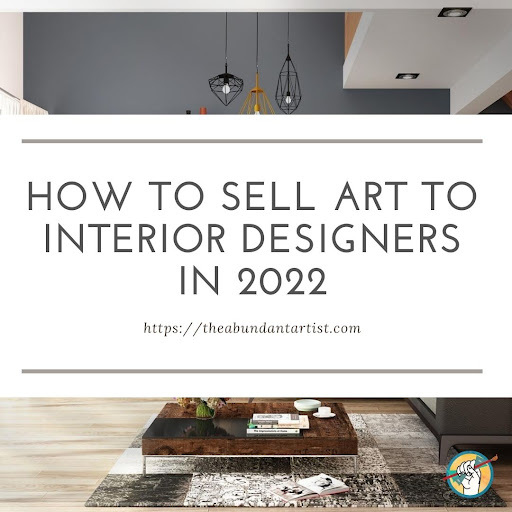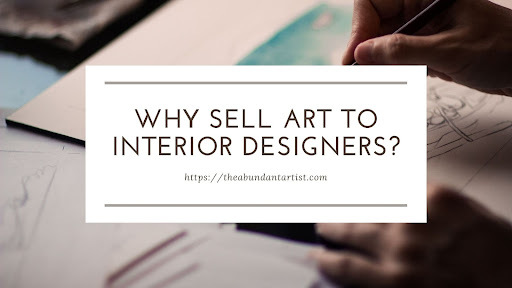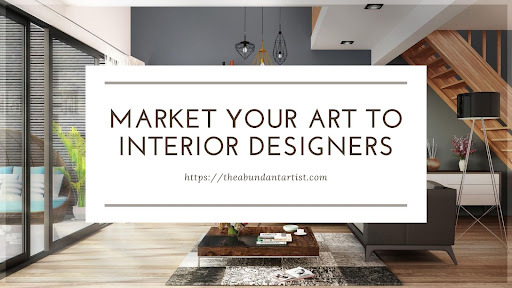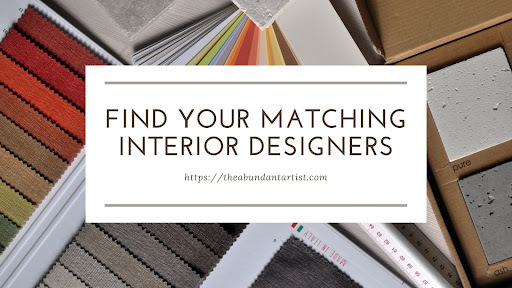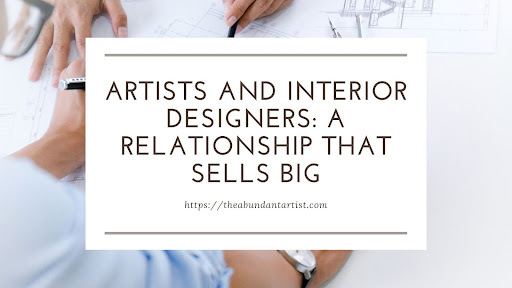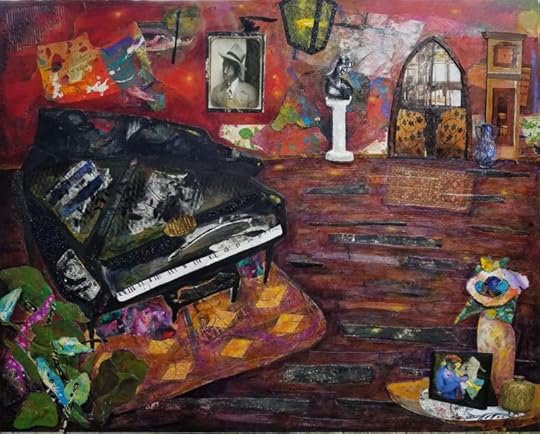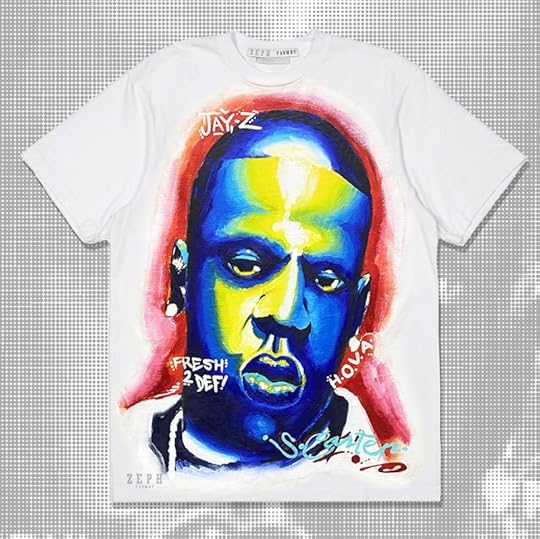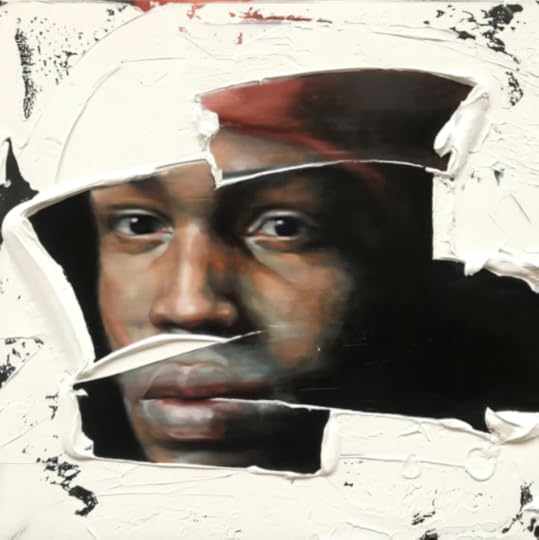Cory Huff's Blog: The Abundant Artist Goodreads blog, page 5
June 15, 2022
How to Sell Art to Interior Designers in 2022
Want to learn how to sell art to interior designers to increase your exposure and supplement your income as an artist? How about picking the brain of an experienced interior designer who knows exactly what kind of art sells best in each design industry?
In this article, you will learn a reliable method consisting of five simple steps to start selling art to interior designers right away.
This article contains:
Why Sell Art to Interior Designers?Market Your Art to Interior DesignersPick Your Interior Design NicheFind Your Matching Interior DesignersPitch Your Art to Interior DesignersSell Your Art to Interior DesignersArtists and Interior Designers: a Relationship that Sells BigWhy Sell Art to Interior Designers?Selling art to interior designers is a lucrative endeavor, and an important part of your art business strategy. There are many reasons to sell art to interior designers:
A Large Market
According to First Research, “The US art dealers and galleries industry include 4,850 establishments in 2022”. Meanwhile, according to Ibis World, “There are 123,254 Interior Designers businesses in the US as of 2022”.
For you as an artist, this means that tapping into the interior design market gives you access to twenty times more clients who need art on a regular basis than if you limit yourself to art dealers and galleries alone.
Quick, Stress-Free Payment
Many designers buy directly from you and resell to their clients. They may buy from you right away or show your art to their clients first. Either way, the money is already in your hand or on its way to your bank as soon as they buy.
Repeat Buyers
The lifetime value of an artist-designer relationship goes beyond a one-time sale. If your artistic style matches the designer’s vision, you’ll be the first they turn to when they need your kind of art again.
Word-of-Mouth Recommendations
Selling art to interior designers creates word-of-mouth marketing opportunities. In today’s connected world, a recommendation from someone who likes your art in their home leads to many more sales down the road.
CV is Irrelevant
Interior designers care a lot less about an artist’s fame, education or experience than art dealers and collectors do. This makes interior designers an excellent starting point for young artists to jumpstart their careers.
Easy to Find and Approach
From official interior design societies to designers’ social media groups, it’s a piece of cake to find a designer whose vision matches your artistic style. When you reach out, they’ll often be happy that you spared them the time to find your art.
Giclée printing lets you print any portion(s) of your artwork in any shape and size to fit any space in an interior designer’s project, making it in high demand. You also get to keep the original, which will appreciate in value as your fame grows.
Access to Real Estate Investors
At some point, you may get to work with an interior designer on an art collector’s or luxury real estate investor’s project; a client who can afford to build a design concept around your artwork instead of fitting your art inside a design concept.
I. Market Your Art to Interior DesignersBeing a professional artist means turning your art into a profession (as opposed to a hobby); making art your primary source of income. To sell your art, you need to market it first; to get it seen by an audience willing to buy it. Therefore, first of all, you need to build a portfolio of art that you can be proud to show to your audience (e.g. interior designers).
Build Your Art Portfolio: Sell Art to Interior Designers on Your Personal Website
The best place to market and sell your art to interior designers and other buyers is your personal website. Doing so:
Eliminates any third-party website’s commissionAllows you to gather customer information for future marketing effortsGrants you the flexibility to arrange and present your art in your own unique wayYour online art portfolio is the first place people look to decide if they want to acquire a piece from you. Therefore, it is worth taking the time to get it right:
Install a premium theme made for artists whose design brings out the best in your artUse plugins to help your site load fast, keep it safe from hackers, and ensure its SEO is optimalIf that’s too hard for now, get started with these top 5 picks for website builders for artists instead.
Launch Your Artist Channels: Sell Art to Interior Designers on Social Media
Social networks – especially Instagram – are quickly becoming the place to find art online, and interior designers are keeping up with this trend. Many designers confess to starting their most profitable partnerships with artists through Facebook. Pinterest is also an excellent marketing tool for artists with its focus on visual content and links to the content’s source.
Using social networks to sell art to interior designers and other art buyers is very popular and, as such, very competitive. Here are a few things you can do to be seen through the competition’s fog:
Post professional pictures of standout artwork on your channelsHighlight links to your portfolio website on your profile and in your postsFollow interior designers that you wish to work withProactively contact designers with a collaboration inquiryWiden Your Artistic Outreach: Sell Art to Interior Designers in Art Marketplaces
While you’re better off selling originals of your art to collectors through your personal website, art marketplaces may work better to sell prints of your art to interior designers.
Build an online presence everywhere designers look to buy art pieces:
EtsyAmazonFineArtAmericaSaatchi ArtShopifyTurningArtUGalleryDesign CentersFreelance WebsitesHouzzDesign Your Art Business Card: Sell Art to Interior Designers in Person
A memorable business card incentivizes interior designers to hold onto your contact details. This makes it easier to look you up the next time they need art for their interior design project.
Here are a couple of ways to make your business card more memorable:
Add a modern twist to this old relic. A QR code can transform a mundane business card into a digital platformPrint a sample of your best art on the card. This tells viewers at a glance if your art style fits any given design projectII. Pick Your Interior Design NicheYou have now set up your art business platforms, and launched your art marketing channels. Congratulations!
The next step in your journey of selling art to interior designers is finding your niche in the interior design market. In which interior design industry does your art sell best?
Sell Art to Interior Designers on the Residential Design Market
Residential Interior Design focuses on high-end properties whose owners usually have a design theme in mind. There is no ‘right art’ for a home – it is down to the owner’s personal taste.
Nevertheless, some trends do come up when selling art to homeowners:
Homeowners disfavor portraits, except for commissioned portraits of the owners’ familiesResidential designers and homeowners favor joyous, uplifting themesMost designers favor bold colors that accent or complement their color paletteClassical paintings infuse life into modern interiorsSell Art to Interior Designers on the Hospitality Design Market
In the past ten years, hotel art has become very trendy: it creates a more welcoming, memorable experience for the guest.
The artwork must not only have relevance to the hotel’s design and location but must also be memorable, and therefore make the hotel stand out from the crowd. Art that tells a story performs especially well to this end.
Sell Art to Interior Designers on the Restaurant Design Market
Fine dining restaurants will tend to have a different artistic feel than a quick-service café; but regardless of sophistication, what matters most in restaurant design is the color palette.
An excess of white or blue hues, for example, backfires in a dining establishment, because cool colors suppress the appetite. Warm tones will be your friend here; studies have found that yellows, oranges, and reds make viewers more ravenous. However, harsh, overly bold colors won’t work well in a restaurant.
Sell Art to Interior Designers on the Retail Design Market
All shops require a degree of shop fitting and thus design. Attractive artwork makes a store more enticing to customers. Artwork must be the right size to entice customers without distracting them.
If it’s too small, customers might struggle to see it, shifting their attention away from the goods being sold. If it’s too large, it can overwhelm the space, decreasing the spaciousness of the room. Medium-sized artworks usually work best.
Sell Art to Interior Designers on the Corporate Design Market
Businesses recognize that workplace interior design plays a big part in employees’ focus, comfort and morale, which helps with staff performance and retention. A couple of considerations to help you sell art on the corporate design market:
Where will the artwork be displayed?
Reception areas or commercial spaces? Create artworks that communicate the value of the business to potential clients.
Meeting rooms? Create standout pieces to inspire the staff even while discussing stressful sales targets or boring legalese.
Offices? Create calming pieces that people can relax around and enjoy without being distracted from work.
What kind of business is it?
For all purposes, match the tone of your artwork to the tone of the business brand. A quirky, creative business can afford to make a bolder statement while an elegant, formal company will likely prefer a more subdued, refined palette.
Sell Art To Interior Designers on the Healthcare Design Market
A few tips to increase your art sales in the healthcare design market:
Focus on landscape art. Studies have shown that realistic nature scenes are often patients’ top choice of artwork themes in hospitals. Specifically, patients like to see art depicting landscapes with lush, green spaces, or scenes that evoke nostalgia or a sense of comfort.
Stay away from abstract art. In healthcare facilities, abstract art tends to increase anxiety among patients. Universally calming and pleasing art is much preferred instead.
Pay close attention to color. Color has an astounding impact on people’s mental and emotional states. Color choice is the key for healthcare facilities, from the color of the walls themselves to the colors in wall art. Cool colors are relaxing, which is beneficial for patients.
III. Find Your Matching Interior DesignersYou have an idea of which interior design industries your art sells best to. Good job! Now it’s time to narrow down which interior designers within these industries to approach first.
Research interior designers’ styles prior to reaching out to find those whose work is in sync with your own. This will make it more likely they pick your art for their projects now and in the future.
Look at interior designers’ websites. Does your art complement their layouts? Cater your offer towards the kind of art they choose to showcase in their portfolios.
Here are a few places where you can find interior designers:
American Society of Interior Designers: ASID’s “Find A Designer” search box returns 50+ pages of interior designers with a description of their specialties and locations
Houzz: Houzz lists over 176,666 interior designers and decorators, offering detailed information about the designer, their services, and their social media profiles
Interior Design Society: IDS has over 2,000 interior decorators specializing in the residential design industry. It allows you to find interior designers by name or location
American Academy of Healthcare Interior Designers: AAHID is an organization of interior decorators certified to render services for the healthcare design industry
List of Corporate Art Consultants and Advisors: This is an annotated, regularly updated list of Corporate Art Consultants and Advisors. It includes their names, mail addresses, phone numbers, and websites. It also gives information on art disciplines and markets of interest
Interior Design Media: A global, industry-leading design publication, website, and events company serving the interior design, architectural, and facility management audiences
Go to Interior Design Events
Interior designers gather at art shows, gallery openings, and studio tours when they’re looking for a new art piece. Having your art featured everywhere might not be possible, but being present yourself at such events to hand out your business card is feasible. Other events to keep in mind include:
Galleries, shows, and exhibitionsNational and international design weekDesign fairs and industry fairsAsk For Recommendations
Ask friends, family, and acquaintances to recommend an interior designer to you or to introduce you to one. Show them your portfolio and propose a collaboration. If your style matches their needs, they will be happy to hear from you.
Browse Design Magazines
Look through interior magazines and contact designers that selected art with a similar style as your own. Let them know of your art, and you’ll be the first they contact when they need your kind of art.
IV. Pitch Your Art to Interior DesignersSo now you know how to find interior designers that may be a good match for your art. But how do you pitch your art to them?
Here are a few tips on pitching your art to interior designers:
Ask if they need artworkOffer to stop by their office and show them art you think they would likeSend them a few samples of your best matching art along with a link to your portfolio websitePitch Your Art to Interior Designers through Email
Only give three to five solid recommendations for a space per round. Once you get feedback on the first round, provide a tailored list of alternativesPersonalized emails perform much better than templated emailsPut attention-grabbing visuals in your email, not just a link to your workCraft an eye-catching subject line to stand out among all the other emailsMake it easy to visualize your work. Create mock-ups of your artwork in designers’ interiorsPitch Your Art to Interior Designers through Social Media
Shoot them a short and sweet message, and they’ll be happy to hear from you. You can also pay to advertise your art to a targeted audience on social media, letting you reach many people quickly.
Master the Elevator Pitch
Be able to pitch yourself, your product, business, etc. in the time it takes to make an elevator ride – about 30 seconds. Practice describing yourself and your art. As your communication skills increase, your career results will keep up.
Pitch Your Art In-Person to Interior Designers
With your elevator pitch ready, go where the designers go and convince them to buy your art.
Have an Enthusiastic Greeting
Start your pitch on a positive note. A friendly, enthusiastic greeting encourages people to stop and listen.
The tone of voice and body language play a big part in attracting and retaining an audience. If you are not fully engaged in your topic, people will sense it and quickly lose interest. Deliver your pitch with an upright stance and a smiling face.
Open Questions Encourage Conversation
Open-ended questions give you valuable information about your customers’ problems and, therefore, the solutions you can offer to them. Sales pitches should evolve into engaging two-way conversations.
Rehearse Different Ways to Deliver Your Pitch
A spontaneous-seeming delivery is all important. People will be put off if it sounds like you’re just regurgitating memorized sales scripts. By practicing various ways to describe the key points of your sales pitch, you will sound more natural and be more engaging.
Handle Rejections
However good your art portfolio or sales pitch, you will still face rejection. All is not lost, though; a friendly, polite attitude may yet secure a future buyer. Thank the designer for their time and attention, and leave them a business card for future reference.
V. Sell Your Art To Interior DesignersThere are several ways to increase not only the chances to sell art to interior designers but also the price of the art sold:
Follow Design Trends
For example, the Pantone Color of the Year 2022 is ‘Very Petri’. It belongs to the blue family, with a violet red undertone.
You can tell this season’s design trends by strolling through high-end furniture stores, interior design studios, or new home models. You can usually anticipate next season’s home décor color trends from this season’s women’s clothing color trends.
This gives you time to create art that matches current or future design trends.
Big Sells
Reasonably priced large works (1 by 1 meter and upwards) are hard to find and often in the greatest demand.
Be Flexible
A willingness to choose or change the color palette, size, or medium of the artwork to fit the design concept can make the difference between a sale and no sale.
A designer will often show you colors and fabrics, and ask if you have art that matches. Even if you don’t, if you are willing to create one to their specifications, you will make a sale eight times out of ten.
Prepare Affordable, Timely Shipping
Designers have deadlines to keep and budgets to meet. It helps them make the decision to buy your artwork if they know when it will arrive and how much it will cost, shipping included.
Keep Your Art Inventory Well-Organized
Designers don’t have time to scour through every artist’s workshop mess, or send out a hundred messages to a hundred artists to ask which pieces are for sale, for how much, and by when. They would like to see your portfolio organized by collections, with each work of art given a price range and a delivery date.
Give Your Art a Story
A good story can increase the value of a work of art. At the very least, explaining some of the concepts behind your work will help the buyer understand its value.
Sell Limited Edition Prints
If you sell prints at all, this will increase their value, especially to art connoisseurs.
Be Prepared for Last-Minute Requests
They will choose you for the sale if you can rescue them in a pinch.
Be Willing to Meet in Person with the Client
Property owners or art consultants might want to witness your personality, or at least hear the story behind your artwork before they buy. Be ready to show up and make a good impression.
Timing Matters
If you show up to a designer at the last minute with art that matches their project, they will rarely hesitate to buy.
Increase Your Productivity with the “Editioning Technique”
That means using more self-contained portions of your existing art as the basis for new, slightly different works of art.
Become a Creative Problem Solver
Instead of just “selling an art piece”, sell yourself as someone who can help the designer by filling in any missing pieces and making suggestions wherever they are stuck.
Present Your Art to the Client Professionally
Help the designer’s client envision the art in the space, feel personally connected to it, and justify its price.
Meet with them in person in order to review details that a digital image alone does not convey, such as scale, texture, and the story behind the art. Bring measuring tape and painter’s tape with you to help the client visualize how your art piece will look over the sofa and scale proportionally within the space.
Negotiate Your Art Prices Fairly
Quality art has a high value, and great interior designers know this. Nevertheless, they may not afford to pay a high price; art is often the last detail they look for – after the bulk of their budget has already been spent.
Keep yourself happy as well as the client with creative solutions. For example, a print instead of an original fits just as well in the design at a more reasonable price point for everyone.
Consider Hiring An Art Consultant
Consultants come with contacts, marketing expertise, and an incentive to help you sell your art. Just as a good agent can skyrocket an actor’s career, and a good editor is invaluable to a writer’s success, so can a good art consultant help you as an artist to break into new markets and command higher prices for your art.
Artists and Interior Designers: A Relationship that Sells BigThe easy task of building a relationship with a designer gives you a repeat buyer who:
Pays on time while increasing your exposure through their own and their clients’ word-of-mouth advertisingKickstarts your career as a professional artist regardless of your background or credentialsMay prefer prints due to their design flexibility, letting you keep the originals to sell to collectors at a higher value
From marketing and targeting to how to pitch and sell art to interior designers, this article has given you every tool you need to start selling your art to interior designers today.
Take the first step and get started on building your art portfolio right away!
About the Guest:
 Raluca Neferu is a fine artist, interior designer, and freelance content writer. Her multidisciplinary experience aids her mission of creating successful partnerships for artists. She welcomes you to enjoy her work on her personal website and to follow her on LinkedIn, Facebook, and Instagram.
Raluca Neferu is a fine artist, interior designer, and freelance content writer. Her multidisciplinary experience aids her mission of creating successful partnerships for artists. She welcomes you to enjoy her work on her personal website and to follow her on LinkedIn, Facebook, and Instagram.
The post How to Sell Art to Interior Designers in 2022 appeared first on Online Marketing for Artists.
June 7, 2022
10 tips for selling art in 2022 (and beyond)
The pandemic drastically changed the fine art market. Yesterday I shared these stats.
2/3 of all art buyers bought art online in 20218/10 people who bought online bought in the last 12 months27% of art buyers will buy an NFTWhen I started TAA in 2009, it was less than 10%. What a difference a decade makes.
Of course, just as many artists were scrambling to adjust, the market shifted again. NFTs took up all the oxygen in the media. A lot of mediocre digital art sold for a lot of money.
Sotheby’s art auctions grew 824% in 2020, but just 22% in 2021. NFTs then plummeted in 2022. Many artists – and many other online business owners – saw their own businesses that benefited from the 2020 online shift experience a massive drop in 2022.
It’s a confusing time to be an artist.
In the last few weeks I’ve been doing a deep dive with artists all over the world. What’s working in selling art? What’s not working? Why? What about NFTs?
I’ve had some time to process my initial reactions to the interviews and read the Hiscox 2022 Online Art Market Report. Today I’m sharing my Top 10 Tips for Selling Art in 2022 and beyond. Keep in mind that these tips are focused on what I’m increasingly calling Indie Fine Artists. Indie because the artists are not necessarily represented by an art gallery or major auction house. They have direct connections to their collectors, and make their own business decisions rather than letting the art industry dictate the meaning and value of their art.
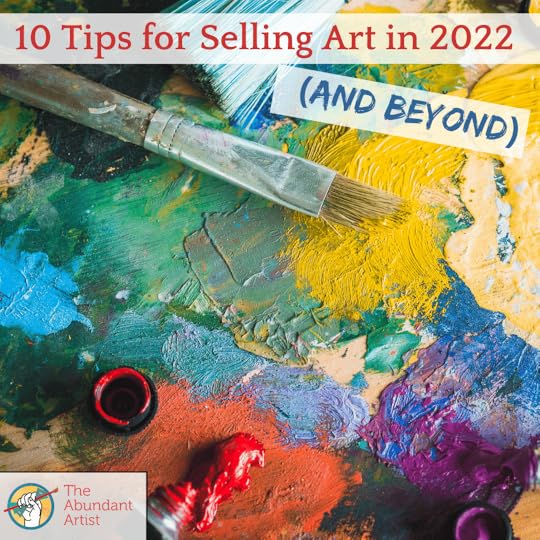
1. Have something to say, and create art in series. Art sells best when you can see that the artist has more than skill. They have a vision, a point of view that is emotionally compelling. They want to move the world and aren’t afraid to create something original. A blunt truth is that art that merely replicates life or copies other work might land a deal with a big licensing company or retailer, but it won’t last. This is just as true in 2022 as it was in all previous years.
2. Nurture your core collectors. Artists who had strong relationships with their collectors before the pandemic thrived. Their collectors doubled down in the pandemic and kept buying. Kevin Kelly’s essay, 1,000 True Fans, has never been more relevant. The hardest sale to get is a new buyer. It’s easier to sell to your core collectors than it is to get a new one. Introversion is an excuse to avoid talking to people. It might be exhausting, but you need to nurture those relationships in order to have a long-lived art career. This doesn’t mean broadcasting your personal life on social media – it means connecting with people on a real level, which can certainly happen over email, text, and social…as well as in real life. Collectors want to know who you are and what your art is about. Give them that and the right people will support you for a long time.
3. Keep up with social media changes. 40% of art buyers say that social media influences what art they buy. This graphic is from Hiscox, about art buyer behavior.
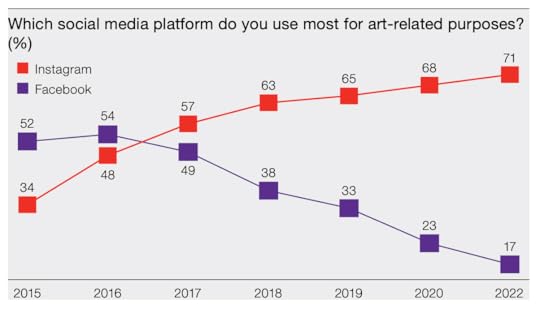
Digging further into the Hiscox data and other sources, it’s obvious that the social media gold rush is on TikTok. Facebook is mostly dead for art collectors. Instagram is fully the king of fine art social unless and until TikTok topples IG. In younger collectors a surprising 26% are finding art on LinkedIn. I have a lot of questions about that last stat, and it needs more research.
Remember that big follower counts don’t matter. Connection does. You can have 1500 followers and sell a lot of art because they know you and love your art. Last week I spoke to an artist with 300k+ followers on Instagram who has only sold three small pieces in the last few months. Engage with your followers and build relationships with them.
4. Offline still matters a lot. Even though collectors are finally buying online, marketing works best when social and email are also used to help collectors know when and where to show up and see a piece, even in nontraditional spaces.
Doing a living room show, a studio visit, an open studio event, art parties and other events are increasingly more and more popular, especially for Indie Fine Artists.
Again, a graphic from Hiscox.
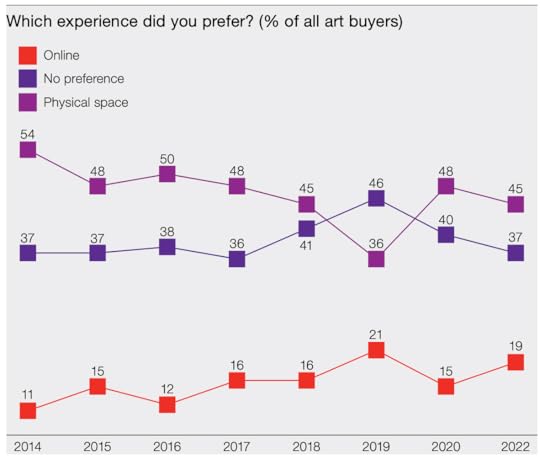
5. Try a virtual show. Several artists that I interviewed have done virtual shows via Zoom. Whether invited 1:1 chats with their favoriate collectors or small group shows, the artists got on live video chat with people, showed off their art, and made direct offers during. Now that pretty much everyone is comfortable with video chat these kinds of shows are gaining popularity with collectors who want to get to know artists from far away without traveling.
6. Do everything you can to show what the work looks like and guarantee its condition. Among the biggest challenges in selling art online are collector concerns over the appearance and condition of the work when it arrives. It’s not enough to share a straight-on cropped shot of the work out of context. Buyers need to know how big it is, what it looks like in different light and contexts, and even what the frames look like. There are many in situ apps that will allow you to preview the art in various ways, even virtually in 3D or in augmented reality.
Your sales pages will benefit from explaining how you package and ship your art, as well as any guarantees or refund policies. This will help collectors believe they can trust you and that the work will look as good in their living rooms as it will on your website.
7. Seriously consider NFTs in your artmaking and/or as a way of showing ownership, provenance, and value. While many now-famous NFTs aren’t necessarily of high artistic value, the fact that 27% of collectors say they plan to buy NFTs means that artists at least need to be educated on what they are and how they can be used to guarantee proof of ownership and provenance. NFT-aligned art also has a temporary advantage of value add due to market forces right now, although that may not be the case after a few years. We recently published a brief overview of what NFTs are and some of the challenges and concerns with NFTs.
Evergreen Suggestions for Selling ArtSome evergreen advice came up during our interviews. These suggestions help no matter what is happening in the economy or in the art market aggregate.
8. Invest in learning how to run a business, especially in learning how to sell. Of the artists we surveyed, most had never taken a class and only read one book, even though they were highly educated with MFAs or BFAs. Knowledgeable competition is actually quite low.
There are lots of books and resources for learning how to sell. At the risk of being completely self-serving, TAA has numerous books and courses. You don’t have to just take our word for it though, and I’d encourage you to learn from several different sources. Our perspective is just one and people have different learning styles and resonate with different teachers.
9. Observe the 50/50 Time rule. Of the time you’re working on your art business, at least 50% should be on marketing and building your audience. This is generally true for most successful artists I know. We’ve been writing and talking about the 50/50 Time rule since 2016.
10. Learn good time management and productivity skills. Know how long an average painting takes. Document how much time you spend marketing and what works. Use basic time blocking techniques to ensure you don’t get distracted. Take time to think about what you’re spending your time on and whether it’s working or needs to change. Charlie Gilkey, a good friend and productivity expert who works with creatives, did a timeless productivity webinar with me a few years ago that is still highly relevant.
Join us this Monday at 1 PM Pacific for a free webinar where I’ll talk about these ideas and more. There will be time for plenty of questions and answers. Join us here.
Also: If you want to join us for the next round of How to Sell Your Art Online 101, we start soon. You can learn more and sign up here.
The post 10 tips for selling art in 2022 (and beyond) appeared first on Online Marketing for Artists.
June 1, 2022
The 2022 Art Sales Bubble & More
Back in March I wrote a whole email series about simplifying the confusion that comes from selling art online. The idea was that so much has changed since early 2020 that a lot of artists have expressed to me that they’re not quite sure what to do now.
That confusion continues.
Last week I asked our readers to book some time to chat with me. About an hour after I sent out the email I had about 35 sessions booked between last Tuesday and this coming Friday. That’s 17.5 hours of talking to artists about what’s on their minds right now. This is often better than doing a survey because you get qualitative feedback and you can ask questions.
So far the artists I’ve spoken to have ranged from brand new beginner to experienced artists selling high price commissions. Here’s a few themes from those conversations:
Yes, we’re on the downside of an online sales bubble. Many artists told me that their sales boomed in 2020 – and then fell off in 2022. If this is you, you’re not alone. That’s true across online sales in general. I know many online business owners, and the broad consensus is that many of the people who started buying things online when the pandemic hit have now reverted back to buying offline. We’re also entering a recession, so spending is trending downward as well. There’s ways to navigate through this period, so don’t freak out, but it is indeed a thing. Many artists who started selling during the 2007-08 recession figured out how to muddle through, either by pivoting to different kinds of sales or by supplementing with day jobs.
Clarify your vision – and start with why. Several artists told me they wanted to “get my art out there.” When I ask them what that means, they talk generally about more people seeing their art and buying more art supplies. “Get my art out there” is a key phrase I listen for that tells me artists haven’t really turned professional yet – either from lack of knowledge or from inner resistance.
Here’s some straight talk: the artists who are selling their art regularly have much stronger reasons for selling. They don’t just want validation. They want their ideas to improve the world – or at least hold up a mirror, to use a cliche. They have a vision of how things can be better and they’re pursuing it vigorously. Some of them start out driven by hunger or a need to feed their kids, but the reality of running your own business means that people who aren’t strongly intrinsically motivated to make art art eventually find a different, often easier, way to support themselves. That’s true not only of artists, but of most people who start a business.
I can usually tell in the first 5 minutes of looking at an artist’s body of work whether the artist has that vision or not. Are they working in a series? Do they have a definite, personalized aesthetic?
The artists who show up win. Half of success is showing up when we say we’re going to and following through on what we say we’re going to do. Excellence can’t be achieved without learning to show up regularly. “When I feel like it” doesn’t work as a time to sell art on a professional level. That said, there are real challenges that prevent some of us from being able to show up in the way we’d like – chronic illness, PhD studies, taking care of children, and others. These obstacles don’t mean you can’t succeed – it might just take longer. I refer you to the 50/50 time rule of art business.
Artists should seek resources for selling their art. Of the artists I spoke to, very few had made a diligent effort to find ways to sell their art. As one artist mentioned, a BFA & MA together only gave her a single semester of professional practice training.
Side note: only academics, and artists with MFAs, call it “professional practice.” If you’re looking for practical advice on selling your art, look for terms like “how to sell art” or “how to get into a gallery” – you’ll get lots of practical advice that isn’t hidden behind jargon.
There are so many books, blog posts, and courses on how to sell art. Whether you take advantage of The Abundant Artist resources or others, it behooves you to educate yourself instead of guessing all the time. We all guess to some degree because that’s the nature of business, but the beginning steps are well documented by many coaches and artists.
I’m enjoying these interviews. It will take me longer to synthesize everything I’ve taken in so far, but I hope you enjoy these initial reactions.
The post The 2022 Art Sales Bubble & More appeared first on Online Marketing for Artists.
May 25, 2022
Championing African-American Art via Black Art In America™ with Najee Dorsey | TAA Podcast Season 5, Episode 9
Welcome to season five, episode nine of The Abundant Artist, the show that dispels the myth of ‘the starving artist’ and shares how you can live an abundant life as an artist and make a living from your talent one interview at a time.
“If you’re interested in legacy and interested in giving, you gotta serve people. If you want to be remembered, you gotta serve,” – Najee Dorsey
In this episode of The Abundant Artist Podcast, Najee Dorsey discusses how Black Art In America is leading the industry by being the top online portal of African American-focused art. We discuss the differences in our cultures and how that affects our artistry and where creation comes from as well as making a positive change in our communities. All this and more!
Najee Dorsey, a visual artist, and entrepreneur, is known for embracing southern roots in his work by relaying scenes of African American life in the south on canvas. He began his journey as an artist at the age of five, selling his artwork to his mother for candy. From that point on, Dorsey continued making art as a favorite pastime.
In 2005, the Dorseys moved to Atlanta, GA, where Najee became a full-time artist. Focusing solely on his art resulted in a fruitful career. Now, more than 10 years later, his work has been featured in nine museum shows. Najee founded Black Art In America™ (BAIA) in 2010 as a free online media platform for African American artists, collectors, art enthusiasts, and arts professionals.
In this episode:
[00:00 – 08:39] Opening Segment
Najee talks about the Poor People’s CampaignInspired by Martin Luther King Jr, Najee desired to create a body of work that addressed tough social issuesProtesting Valero’s pipeline that threatened to damage a majority black community’s waterways with his art[08:40 – 19:50] Black Art In America™
From starting as a community to being the leading online portal and network focused on African-American Art What Community building looks like for Najee[19:51 – 22:03] Artist Communities and Culture
Najee discusses his new project, setting up housing and living facilities for artists The process of partnering with housing authorities How being a part of the community informs the work Najee does The heart to expose more people to the beauty and brilliance of their culture[33:52 – 48:43] The Intersection of Creation and Culture
Najee discusses the art and pieces in his home How our culture and market affect creativity Widen your lens by exposing yourself to broader audiences and diverse schools of thoughtHow can people engage more with black art?Key quotes:
“There are many successful black artists who focus on community building and building community from the bottom up.” – Najee Dorsey
“I want more people to be exposed to the brilliance of our culture and the work that’s being created.” – Najee Dorsey
Resources mentioned:
Allen Stringfellow
Joyce Owens
Kevin Cole
Connect with Najee Dorsey:
najeedorsey.com
Najee Dorsey on Instagram
Najee Dorsey on Twitter
Najee Dorsey on Facebook
About the guest:
 Many descriptive titles could attempt to sum up the profile of Najee Dorsey—World-class Artist, Founder and CEO of Black Art In America (BAIA), Collector, Producer, and Arts Advocate would only be the tip of the iceberg. Those experiences and many more are what have shaped his unique perspective on the art market and its various art worlds.
Many descriptive titles could attempt to sum up the profile of Najee Dorsey—World-class Artist, Founder and CEO of Black Art In America (BAIA), Collector, Producer, and Arts Advocate would only be the tip of the iceberg. Those experiences and many more are what have shaped his unique perspective on the art market and its various art worlds.
The post Championing African-American Art via Black Art In America™ with Najee Dorsey | TAA Podcast Season 5, Episode 9 appeared first on Online Marketing for Artists.
May 24, 2022
How to Write Effective Art Tutorials
When I decided to start an art blog, I was constantly doubting my decision. Every website I researched, every forum I read, and every podcast I listened to told me there was no hope for a blog focused on a visual medium, especially art tutorials.
The constant chant I heard was “video, video, video. You have no hope unless you do video!”
Of course, video is great for visual topics. I fall into the blissful blackholes of YouTube art tutorials as regularly as the next artist. It’s a lovely place to be.
That said, video isn’t the only way to be successful as a content creator in a visual medium. As my blog grew and grew, eventually reaching over 200k pageviews a month, I had proved just that. Even in this video world, there’s still a valuable place for written tutorials.
When done properly, written tutorials can serve readers who want to slow down, take their time, have visual references they can save and use later, and so much more.
Here are some tips for how I write successful art tutorials.
Narrow Down Your TopicThink small when choosing your tutorial topics. Not only will this prevent you from overwhelming your readers, it will also ensure that your tutorials are actionable and practical.
For example, a step-by-step tutorial on using Canva could wander off in any number of directions, leaving your readers unsure of what they’re supposed to be gaining from your article. They may end up asking themselves why they landed on your article in the first place.
On the other hand, a step-by-step tutorial on how to import a Canva presentation into Google Slides has a very clear, actionable outcome. If that Canva presentation isn’t successfully on Google Slides by the end of the tutorial, I’ve clearly missed the mark with my article.
When sitting down to write a tutorial, think about the ONE action item you want your readers to walk away with. Yes, limit yourself to ONE thing.
If it’s helpful, write your one action item on a sticky note that you keep next to your computer. As you’re writing your article, continually refer to the sticky note and ask yourself if you’re helping your readers learn how to complete that one action item. If the answer is “no,” that is a sign you need to refocus.
This one action item needs to direct every single part of your article, from the headline to the conclusion. Any part of your article that doesn’t serve this action item needs to be deleted.
I know this sounds harsh, but it’s the key to writing successful art tutorials.
Especially when writing tutorials about visual mediums, it’s REALLY easy to overwhelm yourself and your readers with tangents that muddle up the steps of your tutorial.
For example, you might be thinking that you’re telling a lovely story about how you accidentally painted your walls with green paint when you were supposed to use pink. Suddenly, your readers are using green paint for their sunsets. It sounds silly, but it happens. Any tangent could accidentally be misconstrued as an instruction.
With videos, it’s easier to get away with tangents because your audience can see your process. They can see that you aren’t reaching for green paint instead of pink. They can follow along with the visuals of your process, even if you’re telling a tangential story at the same time.
There’s no wiggle room for this with written tutorials. Yes, you can use images to your advantage, which we’ll talk about later on, but don’t rely on your images to clear up any confusion you create by going on a tangent or straying too far from your topic.
Focus on ONE clear action item per tutorial and be aware whenever you stray from it. This will increase the chance that your readers will leave your article with a sense of accomplishment instead of confusion.
Take a Beginner’s MindsetAs you’re writing your tutorial, assume your readers are beginners. In fact, assume you’re a beginner too!
Adopting a beginner’s mindset will ensure that you include every single miniscule step that’s required for your tutorial. No matter how tedious and small those steps may be.
Yes, this level of detail may drive you bonkers as you’re writing, but it will benefit your readers. It will also help you avoid any unintentional knowledge gaps.
If you skip a step during a video tutorial, it may be confusing, but viewers can rewind the video and watch the process over and over again to fill in their own knowledge gaps.
If you skip a step during a written tutorial, there’s nothing for your readers to look back upon to put the pieces together and fill in their own knowledge gaps. They’re simply left wondering how the steps of your tutorial are even related to each other.
The way I avoid this is by adopting a beginners mindset. Even if I’m confident in a topic, I will start from scratch and complete every single step myself while I write my tutorial.
For example, I wrote a tutorial for integrating an online Etsy store with Printful. Even though I’d used both of these platforms to sell my art for a long time, for the purposes of the tutorial, I started from scratch.
I personally went through the whole process from start to finish as though I were a brand new user and documented every single step, from confirming the email address to uploading art to the store.
What resulted was a LONG tutorial that looks ridiculously detailed from first glance.
Since I published that tutorial though, I’ve gotten positive feedback about how in-depth the instructions were.
The reason why? I adopted the same beginner’s mindset that my readers have, which led me to include steps and instructions that those writing from an expert position may have overlooked.
When writing your own art tutorials, pretend like you’re a newbie. This will go a long way in ensuring your tutorials are thorough and extensive.
Take Advantage of the Differences between Articles and VideosWhen writing a tutorial, make sure to take advantage of everything a blog post can offer. If all you’re going to do is write the equivalent of a video transcript, you’re leaving some valuable resources on the table.
There are some neat things you can do with articles that you can’t do with videos, so make sure to make the most of them.
Include links. One of the biggest perks of creating written tutorials is taking advantage of internal links. Unlike video tutorials, written tutorials give you a seamless way to include links within your tutorials that can help your readers expand their knowledge and dive deeper into a topic.I’m a huge fan of linking between my tutorials. Not only does this help keep readers on my website, it also ensures they have all of the resources they need on a topic.
Use text formatting to your advantage. Bold, italicize, underline, and emphasize your text to make a point! Instead of giving your readers a block of text to read, use your formatting to help them understand each step of your tutorial. Put each step in bold, underline important aspects, and italicize keywords. Make your formatting work for you as you write your tutorials.Create images. Just because you’re doing a written tutorial doesn’t mean you need to throw away visual mediums altogether. Strategically using images in your written tutorials can be extremely helpful in making sure that your written tutorials are as helpful as possible for your readers.Personally, I include images everywhere I can within my tutorials. For example, every time I tell someone to click on a button, I take a screenshot of my screen and put a circle around that button. I want to take any potential hurdle or guesswork out of the equation.
When in doubt, take a picture.
Pictures can go a long way in reinforcing the instructions you’re providing, shoring up any accidental knowledge gaps, and offering a more engaging tutorial overall.
If you want to take your images a step further, consider making infographics that outline your tutorial, step by step. This can give your readers a valuable resource they can save and refer back to in the future.
When done correctly, written tutorials can be extremely valuable for content creators who want to help their readers learn specific skills in the art world.
Despite its visual nature, art tutorials are not a “video or bust” situation. Whether you want to show your readers how to paint a sunset, or how to upload their art to their first online store, written tutorials are still an incredibly valuable way to teach and learn.
About the author:
 Diana Fitts has been an artist for over 25 years, and has training in drawing, painting, digital drawing and graphic design. Diana’s latest obsessions are digitally drawing with Procreate and creating t-shirt designs with Canva. She has experience selling her art across a number of platforms, and loves helping other artists learn how to make money from their art as well.
Diana Fitts has been an artist for over 25 years, and has training in drawing, painting, digital drawing and graphic design. Diana’s latest obsessions are digitally drawing with Procreate and creating t-shirt designs with Canva. She has experience selling her art across a number of platforms, and loves helping other artists learn how to make money from their art as well.
The post How to Write Effective Art Tutorials appeared first on Online Marketing for Artists.
May 17, 2022
How (and Why) to Stage Living Room Shows
For years I’ve been telling artists to focus on what they can do right away to start making sales now rather than waiting for a gallery to pick them. One way of doing that is to fill a living room, and let that give you momentum toward a big gallery opening or a huge mailing list.
Several years ago, Tara McMullin wrote a blog post called The Power of the Living Room Strategy. It’s a simple strategy for business owners who don’t have a big network or list of people waiting to buy from them.
Why a Living Room Show?“It’s a heckuva lot easier—and often much more rewarding both financially and energetically—to fill a living room instead of a stadium.”
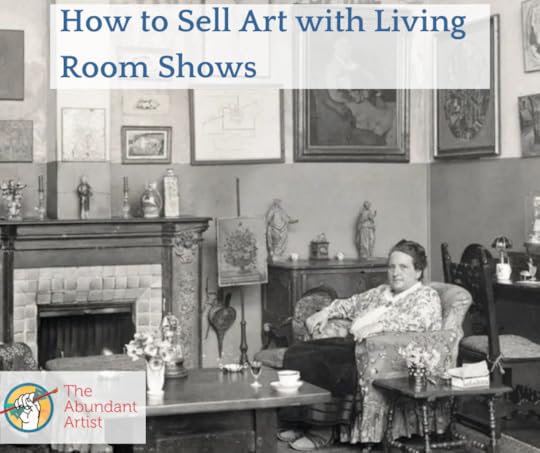
Before Pablo Picasso was famous, he had Getrude Stein’s living room salon. Most good galleries have more artists than they can adequately represent, so getting even a group show with a gallery might take years. Most artists don’t have the financial means to wait that long.
Selling art online doesn’t require waiting, but the competition is fierce. Whether it’s a social network, a print-on-demand site, or an online marketplace site, there are hundreds of thousands of artists competing for the same eyeballs. If you don’t know how to draw a ton of attention to your work, and the idea of doing so makes you feel slightly ill, pursuing a living room strategy is a great alternative.
What Does a Living Room Show Look Like?In its basic form, a living room show means:
invite five to ten people into your living roomdisplay 3 – 5 pieces of your art in the spaceshare some drinks and snackssocialize for 45 minutesgive a five-minute talk about your art, and mention that the work is for sale if anyone is interestedanswer questionsgo back to socializing for as long as you likeThat’s it. Low pressure and no direct sales pitches.
And it works. It works because most of us can find ten friends to have a fun night together. It works because when there’s no pressure, people are more open to the kind of emotional experiences that art creates. It works because when the artist is there explaining some context for the art, it gives people an emotional way into the work. It works because friends of friends are the best way to leverage weak ties to grow your collector base.
There are a few things you might want to add to your living room show if you want to take it up a notch, but you don’t have to do these things.
Instead of doing it in your living room, do it in the living room of someone who loves your art, especially a collectorHave your collector host invite their friends so the group is a mix of your people and their peoplePractice your five-minute talk in advanceBring your card reader so you can sell the work onsite—or at least have a Venmo or CashApp account readyIf you are just starting out selling your art, I recommend trying to schedule one living room show per month. Start with your friends and family. Then ask them to invite their friends and family to a show in their home. Most of us are just two or three connections away from people who love to buy art, even if we grew up in poor circumstances.
Also note: living room is a general term. It could be a kitchen show. It could be a house party or industrial party. You’ll notice that several of the artists we had on the podcast recently, like Zsudayka Nzinga and Zeph Farmby, got their start by showing their art at parties. Jesse Reno showed his work at parties at abandoned industrial buildings.
What Kind of Results Do Living Room Shows Produce?I’ve been teaching artists how to do this in private coaching sessions for years. The artists who do it find that it’s not very difficult, and it creates surprising results. People they don’t know buy from them, and people they don’t know connect them with opportunities to show their work in museums, galleries, corporate collections, cafes, and other places.
Living room shows also create great fodder for social media marketing and your email list. A selfie with the group, tagging everyone, creates great social proof that people are interested in your art, and it makes you look fun.
A few years ago, one artist I worked with to plan a six-month living room show campaign saw fast and surprising results. This artist, a landscape painter, had just a handful of sales going into the campaign. She asked less than ten people to host and immediately booked three living room shows in their homes. The collectors invited their friends. From those shows, the artist made several sales, booked a residency retreat through a friend of a friend, and booked a group show.
She decided to double down on doing living room shows and made a plan to do two shows per month. She pursued that for a year and that acted as a springboard to launch her sales to a level that she was thrilled about. She’s now working on a new series of work. She can be confident about it because she now has a track record of sales, collectors are interested in the new series, and she knows that even if a gallery won’t take the new series, she has direct relationships with collectors and fans who will support her.
By pursuing a simple, achievable strategy of strengthening your network and building personal relationships, you’ll give yourself a great start at selling your art.
Do you do living room shows? Drop a comment and let us know about your additional tips.
The post How (and Why) to Stage Living Room Shows appeared first on Online Marketing for Artists.
Living Room Shows
For years I’ve been telling artists to focus on what they can do right away to start making sales now rather than waiting for a gallery to pick them. One way of doing that is to fill a living room, and let that give you momentum toward a big gallery opening or a huge mailing list.
Several years ago, Tara McMullin wrote a blog post called The Power of the Living Room Strategy. It’s a simple strategy for business owners who don’t have a big network or list of people waiting to buy from them.
Why a Living Room Show?“It’s a heckuva lot easier—and often much more rewarding both financially and energetically—to fill a living room instead of a stadium.”

Before Pablo Picasso was famous, he had Getrude Stein’s living room salon. Most good galleries have more artists than they can adequately represent, so getting even a group show with a gallery might take years. Most artists don’t have the financial means to wait that long.
Selling art online doesn’t require waiting, but the competition is fierce. Whether it’s a social network, a print-on-demand site, or an online marketplace site, there are hundreds of thousands of artists competing for the same eyeballs. If you don’t know how to draw a ton of attention to your work, and the idea of doing so makes you feel slightly ill, pursuing a living room strategy is a great alternative.
What Does a Living Room Show Look Like?In its basic form, a living room show means:
invite five to ten people into your living roomdisplay 3 – 5 pieces of your art in the spaceshare some drinks and snackssocialize for 45 minutesgive a five-minute talk about your art, and mention that the work is for sale if anyone is interestedanswer questionsgo back to socializing for as long as you likeThat’s it. Low pressure and no direct sales pitches.
And it works. It works because most of us can find ten friends to have a fun night together. It works because when there’s no pressure, people are more open to the kind of emotional experiences that art creates. It works because when the artist is there explaining some context for the art, it gives people an emotional way into the work. It works because friends of friends are the best way to leverage weak ties to grow your collector base.
There are a few things you might want to add to your living room show if you want to take it up a notch, but you don’t have to do these things.
Instead of doing it in your living room, do it in the living room of someone who loves your art, especially a collectorHave your collector host invite their friends so the group is a mix of your people and their peoplePractice your five-minute talk in advanceBring your card reader so you can sell the work onsite—or at least have a Venmo or CashApp account readyIf you are just starting out selling your art, I recommend trying to schedule one living room show per month. Start with your friends and family. Then ask them to invite their friends and family to a show in their home. Most of us are just two or three connections away from people who love to buy art, even if we grew up in poor circumstances.
Also note: living room is a general term. It could be a kitchen show. It could be a house party or industrial party. You’ll notice that several of the artists we had on the podcast recently, like Zsudayka Nzinga and Zeph Farmby, got their start by showing their art at parties. Jesse Reno showed his work at parties at abandoned industrial buildings.
What Kind of Results Do Living Room Shows Produce?I’ve been teaching artists how to do this in private coaching sessions for years. The artists who do it find that it’s not very difficult, and it creates surprising results. People they don’t know buy from them, and people they don’t know connect them with opportunities to show their work in museums, galleries, corporate collections, cafes, and other places.
Living room shows also create great fodder for social media marketing and your email list. A selfie with the group, tagging everyone, creates great social proof that people are interested in your art, and it makes you look fun.
A few years ago, one artist I worked with to plan a six-month living room show campaign saw fast and surprising results. This artist, a landscape painter, had just a handful of sales going into the campaign. She asked less than ten people to host and immediately booked three living room shows in their homes. The collectors invited their friends. From those shows, the artist made several sales, booked a residency retreat through a friend of a friend, and booked a group show.
She decided to double down on doing living room shows and made a plan to do two shows per month. She pursued that for a year and that acted as a springboard to launch her sales to a level that she was thrilled about. She’s now working on a new series of work. She can be confident about it because she now has a track record of sales, collectors are interested in the new series, and she knows that even if a gallery won’t take the new series, she has direct relationships with collectors and fans who will support her.
By pursuing a simple, achievable strategy of strengthening your network and building personal relationships, you’ll give yourself a great start at selling your art.
Do you do living room shows? Drop a comment and let us know about your additional tips.
The post Living Room Shows appeared first on Online Marketing for Artists.
May 11, 2022
Creating Art That is Authentically You with Multidisciplinary Artist Zeph Farmby | TAA Podcast Season 5, Episode 8
Welcome to season five, episode eight of The Abundant Artist, the show that dispels the myth of ‘the starving artist’ and shares how you can live an abundant life as an artist and make a living from your talent one interview at a time.
Multidisciplinary artist Zeph Farmby joins the podcast today to share his journey as an artist from tagging on the streets to selling his shirts in major stores, being noticed and commissioned by A-list clients, creating original pieces for broadcasts worldwide, and showcasing his work in exhibitions. Combining his graffiti skills with his formal art education, Zeph’s unique art style stands out in the crowd.
In this episode, Zeph shares about the major influences in his life and art, how he stays true to art, his experiences with getting a formal art education, his entire art journey, and his advice to young artists on how to build a sustainable art business that allows you to make a living.
In this episode:
[:30] How Zeph and Cory first met.
[1:46] Would Zeph describe himself as a “collage artist”?
[2:37] How Zeph first got started as a graffiti artist.
[6:03] Zeph explains some of the culture and terms of graffiti.
[13:05] Major influences on Zeph’s style and how his art journey led to where he is today.
[17:45] Zeph’s journey from not being able to sell a T-shirt at the local flea market to having his
shirts solid in one of the hottest stores in Chicago.
[27:43] How wanting a hat influenced Zeph and his art in a major way.
[31:49] Zeph shares about his journey and development of marrying his two styles together.
[40:13] Zeph shares more about his art journey after moving out of Chicago and one of the
pivotal pieces he created that helped him not only stand out in the crowd but get noticed by big-
time music producer, Swizz Beatz.
[49:48] Zeph shares his experiences and experimentations with art exhibitions and installations
in Chicago and New York from 2016 onward.
[54:30] Zeph’s business breakdown and his main sources of income as an artist.
[56:16] Zeph’s advice to young artists on how to build a sustainable art business that allows you
to make a living.
[58:08] How does Zeph manage to balance murals, originals, commissions, merchandise, etc? Is
it difficult or enjoyable to switch between these different aspects of business?
[1:00:09] Cory thanks Zeph for joining the podcast.
Mentioned in this episode:
Zeph Farmby
Clubhouse
Mr. Brainwash
About the guest:
 Zeph Farmby is a Chicago-born, Brooklyn, NY-based, multi-disciplined artist. Zeph began as a graffiti artist and established a corresponding studio practice at The Art Institute of Chicago. Specializing in painting, muralism, installation, apparel and graphic design, his career spans more than 20 years. Selected as the 2021 Soho House – Soho Works Artist-in-Residence, he has exhibited globally including mural projects in Haiti and Japan. His work has been collected and worn by Kayne West, Jay Z, Swizz Beatz and Pharrell Williams amongst others. His artwork and apparel designs have also been featured with The New York Times, Complex Magazine, Hypebeast and Vice.
Zeph Farmby is a Chicago-born, Brooklyn, NY-based, multi-disciplined artist. Zeph began as a graffiti artist and established a corresponding studio practice at The Art Institute of Chicago. Specializing in painting, muralism, installation, apparel and graphic design, his career spans more than 20 years. Selected as the 2021 Soho House – Soho Works Artist-in-Residence, he has exhibited globally including mural projects in Haiti and Japan. His work has been collected and worn by Kayne West, Jay Z, Swizz Beatz and Pharrell Williams amongst others. His artwork and apparel designs have also been featured with The New York Times, Complex Magazine, Hypebeast and Vice.
The post Creating Art That is Authentically You with Multidisciplinary Artist Zeph Farmby | TAA Podcast Season 5, Episode 8 appeared first on Online Marketing for Artists.
May 3, 2022
What are the issues that face the NFT market?
Google searches for “NFT scam” peaked in January 2021 as people feared for their online safety on the new and ever-developing platform. Despite NFTs being around since 2014, this past year has seen the market boom. In fact, 2021 marked the year that NFTs broke into the mainstream, and they are quickly evolving. The NFT boom has, however, created new exploitation opportunities for scammers.
This article will provide information on what to look out for and knowledge of the issues within the industry, which will help you avoid coming into trouble and raise awareness of the nature of the marketplace from Fracas Digital NFT Agency.
ScamsHigh rewards with little risks and regulations are what have enticed scammers to target the decentralized ecosystem. Crypto scams have been getting increasingly more sophisticated and convincing, causing a real need for caution when dealing with NFTs.
Scams come in many shapes and forms but follow the format of most readily known online issues, such as catfishing and fake personas, suspicious pop-ups, suspicious looking URLs, deals which seem “too good to be true”, and phishing scams.
The online platform Discord sees the appearance of the most online scam opportunities as hackers gain administrator-level access to the servers, and publish fake links and deals to entice unsuspecting users.
Gas feesWhat are the gas fees?
Gas fees are essentially a payment users have to make to go towards the computational energy required to process transactions on the Ethereum Blockchain, and are measured in units of Gwei. Gas fees are comparable to credit card fees that may charge you for transferring money.
Ethereum has a gas problem as a result of limited bandwidth, which often catches users who are new to the market off guard, as the fees can be high and volatile leaving new buyers confused and out of pocket.
Environmental ConcernsGas fees and other processes in the industry can also cause environmental concerns. Many of the computers, that enable technologies like this to operate at their highest level, require large amounts of electricity. There is growing concern within the industry that with further adoption of such technologies, these problems could be exacerbated.
Volatility“Pump-and-dump” schemes are an increasingly common form of speculation in the crypto and NFT worlds. “Pump-and-dump” is when a group of people buy multiple NFTs or currency with the intention to artificially drive up demand. Once they are successful (i.e. demand and prices heightened), they will cash out and leave those who weren’t in on it behind with worthless assets. Tactics like this have been seen throughout the history of the stock market, but, with the limited regulations on the NFT market and its volatile nature, they are commonplace.
The issue is a result of attempts to bridge digital and physical in terms of how assets are both tracked and valued. Although this has always been a problem with the art market, how does one value the price of art? The NFT market has less previous data to rely upon to make stable valuations as the process is so new.
What to invest in?Although the NFT marketplace for digital collectibles is booming, it doesn’t mean they are a safe investment.
Anyone on the internet can create an NFT out of literally anything, which means there are a lot of bad tokens available for purchase (that might not necessarily be priced accordingly). It takes a trained eye and vast knowledge on key players in the industry to see what’s worth investing in.
Lack of Know Your Client (KYC) proceduresKYC or know your client procedures are an element of the NFT market which remains rarely exercised and is still lacking regulation. Although all information about an NFT is visible on a digital record on the blockchain, this does not in itself weed out catfish and fake personas allowing individuals to pose as owners or creators of pieces and fraudulently cash in on someone’s creation or property.
KYC measures are additionally seen as an unattractive measure to implement on the NFT marketplace as it requires longer processes, taking time and data submission, thus slowing down a process which is unique for its instantaneous qualities. Companies and organizations do not want to risk losing clients. KYC measures may be slow to arrive in the NFT marketplace.
Money launderingFinally, the NFT market has created an opportunity for easy online money laundering.
Given the lack of KYC procedures, money laundering can be exercised through purchasing an NFT for a large amount of money, and then selling the NFT to a third-party account (that they own indirectly) for a lesser amount to write off a considerable amount of money and effectively reduce their tax liabilities. This is one of a number of ways in which money laundering can be carried out that is difficult to be found and prevented.
Although the NFT market has seen rapid growth within the last year with many new supporters and adopters using the platform, there is still some way to go before this particular market is considered as “safe” as more traditional markets. While skeptics may see these issues as “deal breakers” for the NFT market, current users just see these issues as growing pains that will be ironed out with further adoption.
——————————————————————————————–
For tailored advice on how to begin your journey into the metaverse, visit Fracas Digital.
The post What are the issues that face the NFT market? appeared first on Online Marketing for Artists.
April 28, 2022
Existentialism & Augmented Reality with Cesar Biojo | TAA Podcast Season 5, Episode 7
Welcome to season five, episode seven of The Abundant Artist, the show that dispels the myth of ‘the starving artist’ and shares how you can live an abundant life as an artist and make a living from your talent one interview at a time.
This week, Cesar Biojo joins the podcast! Cesar is a Barcelona-based Colombian oil painter and co-founder of Kaleido, an online network that supports artists, collectors, and art galleries alike.
In their conversation together, Cesar shares about his process of creating his unique existential artwork, why existentialism fuels his work, and his invaluable advice on growing as an artist, becoming a better communicator, delving deeper into your work, and discovering your purpose. He also shares about Kaleido, its mission, and its fascinating augmented reality feature that allows users to virtually explore an artist’s gallery.
In this episode:
[:30] Why Cesar often quotes Sartre alongside his work.
[6:04] How did Cesar find/create his purpose?
[10:55] How Cesar creates his work and how the concept of existentialism influences
his process.
[14:44] How art and therapy collide.
[17:19] Cesar’s advice to young artists around the intersection of therapy, making a
career of art, and inspiration.
[19:28] Cesar’s tips for growing and exploring as an artist.
[21:40] Why being able to explore existentialism, emotion, and philosophy can make
you a better communicator but not necessarily a better artist.
[22:48] Cesar’s insights on whether or not you need a formal education to “make it” as
an artist.
[24:22] What Kaleido is, what its mission is, and why Cesar is a part of it.
[28:47] About the augmented reality feature that is unique to Kaleido
[30:00] Cesar’s involvement in Kaleido and how Kaleido protects artists.
[33:06] Cesar’s predictions on NFTs.
[35:44] Cesar discusses the progression and future of augmented reality.
[39:55] Where they are planning on heading with Kaleido regarding augmented reality.
[42:50] Where and how to learn more about Kaleido.
[47:25] Cory thanks Cesar for joining the podcast!
Mentioned in this episode:
Cesar Biojo
Instagram @CesarBiojo
“How Cindy Sherman Redefined Self-Portraiture”
Kaleido
Ready Player One (2018, Film)
Minority Report (2002, Film)
Neuromancer by William Gibson
About the guest:
 Cesar Biojo (1981, Cali, Colombia) holds degrees in Fine Arts and Art History from Florida State University, and currently works on a Ph.D. in Art Research from the University of Barcelona. His works are oil portraits created from pictorial resources that are destroyed immediately leaving an evidence behind. This way the concept of time is introduced, connecting concepts inherent in the human being such as creation and destruction, the perishable and ephemeral. His work recovers in some cases post-impressionist styles, resulting in a personal language that makes his art project one of the most interesting in the contemporary scene. Taking as starting point the quote of Jean Paul Sartre, “The gaze of the other makes us aware of ourselves”, his work becomes an introspective study of human beings, their conflicts, their nature and existence. His work has taken part in a number of national and international exhibitions. He lives and works in Barcelona, Spain.
Cesar Biojo (1981, Cali, Colombia) holds degrees in Fine Arts and Art History from Florida State University, and currently works on a Ph.D. in Art Research from the University of Barcelona. His works are oil portraits created from pictorial resources that are destroyed immediately leaving an evidence behind. This way the concept of time is introduced, connecting concepts inherent in the human being such as creation and destruction, the perishable and ephemeral. His work recovers in some cases post-impressionist styles, resulting in a personal language that makes his art project one of the most interesting in the contemporary scene. Taking as starting point the quote of Jean Paul Sartre, “The gaze of the other makes us aware of ourselves”, his work becomes an introspective study of human beings, their conflicts, their nature and existence. His work has taken part in a number of national and international exhibitions. He lives and works in Barcelona, Spain.
The post Existentialism & Augmented Reality with Cesar Biojo | TAA Podcast Season 5, Episode 7 appeared first on Online Marketing for Artists.
The Abundant Artist Goodreads blog
- Cory Huff's profile
- 31 followers


